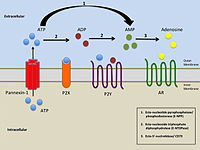| Part of a series on |
| Purinergic signalling |
|---|
 |
| Concepts |
| Membrane transporters |
| Pannexin | |
|---|---|
| Identifiers | |
| Symbol | Pannexin |
| InterPro | IPR039099 |
| TCDB | 1.A.25 |
| pannexin 1 | |||||||
|---|---|---|---|---|---|---|---|
| Identifiers | |||||||
| Symbol | PANX1 | ||||||
| NCBI gene | 24145 | ||||||
| HGNC | 8599 | ||||||
| OMIM | 608420 | ||||||
| RefSeq | NM_015368 | ||||||
| UniProt | Q96RD7 | ||||||
| Other data | |||||||
| Locus | Chr. 11 q14-q21 | ||||||
| |||||||
| pannexin 2 | |||||||
|---|---|---|---|---|---|---|---|
| Identifiers | |||||||
| Symbol | PANX2 | ||||||
| NCBI gene | 56666 | ||||||
| HGNC | 8600 | ||||||
| OMIM | 608421 | ||||||
| RefSeq | NM_052839 | ||||||
| UniProt | Q96RD6 | ||||||
| Other data | |||||||
| Locus | Chr. 22 q13 | ||||||
| |||||||
| pannexin 3 | |||||||
|---|---|---|---|---|---|---|---|
| Identifiers | |||||||
| Symbol | PANX3 | ||||||
| NCBI gene | 116337 | ||||||
| HGNC | 20573 | ||||||
| OMIM | 608422 | ||||||
| RefSeq | NM_052959 | ||||||
| UniProt | Q96QZ0 | ||||||
| Other data | |||||||
| Locus | Chr. 11 q24.2 | ||||||
| |||||||
Pannexins (from Greek 'παν' — all, and from Latin 'nexus' — connection) are a family of vertebrate proteins identified by their homology to the invertebrate innexins.[1] While innexins are responsible for forming gap junctions in invertebrates, the pannexins have been shown to predominantly exist as large transmembrane channels connecting the intracellular and extracellular space, allowing the passage of ions and small molecules between these compartments (such as ATP and sulforhodamine B).
Three pannexins have been described in Chordates: Panx1, Panx2 and Panx3.[2]
- ^ Panchin Y, Kelmanson I, Matz M, Lukyanov K, Usman N, Lukyanov S (June 2000). "A ubiquitous family of putative gap junction molecules". Current Biology. 10 (13): R473-4. Bibcode:2000CBio...10.R473P. doi:10.1016/S0960-9822(00)00576-5. PMID 10898987. S2CID 20001454.
- ^ Litvin O, Tiunova A, Connell-Alberts Y, Panchin Y, Baranova A (2006). "What is hidden in the pannexin treasure trove: the sneak peek and the guesswork". Journal of Cellular and Molecular Medicine. 10 (3): 613–34. doi:10.1111/j.1582-4934.2006.tb00424.x. PMC 3933146. PMID 16989724.